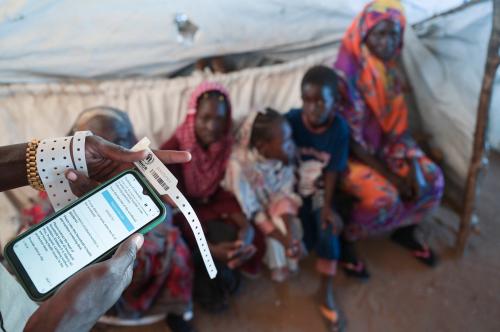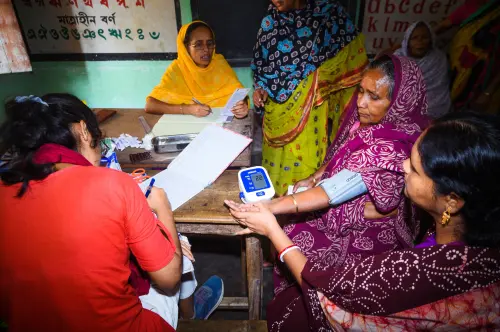This meeting summary reflects discussions from a virtual roundtable co-hosted by the Brookings Center for Sustainable Development (CSD) and Co-Develop on Monday, July 21, 2025, from 10:00–11:30 a.m. ET. Participants came from the public and private sectors, multilateral institutions, civil society, and foundations.
Digital assets—software, data, and the protocols connecting them—scale differently from concrete and steel. Once built, one codebase or cleaned dataset can serve millions more at near‑zero marginal cost. Each new user lowers average costs, strengthens network effects, and makes platforms more resilient. For governments, this “re‑use” logic underpinning digital service delivery means inclusion and efficiency can potentially advance together.
Yet most governments and the lenders on which they rely for financing typically approach digital systems as if they were one-off “languages” for every ministry. Only rarely are digital assets deployed in one context re-used by another agency in the same country—let alone re-used by another country. Multilateral development bank (MDB) financing was originally designed for physical infrastructure: capital-intensive projects with limited scope for iteration or upkeep. Meanwhile, very few low- and lower-middle-income governments are equipped with the institutional capacity to proactively develop and operate common digital infrastructure across ministries.
As a result, most digital development projects remain siloed within ministries and expensive for governments to maintain. In a world of shrinking development finance and rising government debt, low to middle-income countries simply cannot afford to waste billions of dollars re-engineering duplicative digital systems. Finding better ways to incentivize digital infrastructure re-use—both within and between countries—is as much an urgent economic imperative for governments as it is an urgent moral imperative for lenders.
As advanced within a growing movement for digital public infrastructure (DPI), a more efficient starting point is to think of digital infrastructure development in terms of building common “grammars” that can be re-used and adapted by multiple actors within and across countries according to use-case specific needs. But the potential dividends from digital infrastructure’s re-use—faster delivery, lower overall costs, and wider coverage—are not limited to DPI’s core systems of digital identification, real-time payment, and data exchange. These systems, after all, represent only a small fraction of total global government spending on digital infrastructure and services.
In this context, MDBs and governments alike have only recently begun to consider ways of partnering more effectively to finance and deploy digital infrastructure. The key question is how can these actors collectively shift gears from incremental reforms to a comprehensive effort to capture digital infrastructure’s re-use dividend within and across countries?
To chart potential paths forward for smarter MDB financing for country deployment of digital infrastructure, in July 2025, Brookings CSD and Co‑Develop convened a multistakeholder private roundtable discussion to identify practical ways MDBs can support digital infrastructure re-use without compromising sovereign control. The conversation surfaced a range of promising work already underway across MDBs aimed at incentivising digital infrastructure re-use through four interlocking levers: transforming incentives, aligning approaches, agile deployment, and continuous development. Several opportunities for global action to unlock DPI’s re-use dividend were also considered.
Key discussion takeaways for digital infrastructure re-use levers and possible shared action are summarized below.
1. Transforming incentives
The pattern of siloed or one-off digital systems can be traced to the incentives that drive government decisionmakers and lenders. Ministry budgets and accountability lines typically flow vertically, rewarding decisionmakers for delivering on narrow mandates rather than building common platforms. MDB loans tend to mirror this structure—matching financing to ministerial silos—and in doing so disincentivize digital infrastructure’s re-use potential.
Breaking this cycle requires shifting the incentives at both levels. Governments could adopt shared funding models to reward pooling mandates and budgets across ministries, while MDBs can structure smaller, modular loans that encourage cross-ministry and cross-sector cooperation and re-use as an economic necessity. With both governments and lenders moving in tandem to transform incentives, digital infrastructure re-use could become the easier choice.
2. Aligning approaches
Roundtable participants pointed out that incentives for re-using digital assets can emerge from greater shared understanding among MDBs and governments of digital infrastructure procurement, protocols, and governance options that support re-use. For instance, as advanced within the World Bank’s global multistakeholder DPI working group and the IDB’s country engagements, clarifying a full range of digital infrastructure procurement options and their trade-offs—from home‑grown open source and vendor‑delivered open source to public‑private partnerships with mixed proprietary stacks—can help countries make evidence‑based choices that balance re-use potential with considerations around sovereignty and autonomy.
Re-use also requires increasing technical interoperability between infrastructure components and consolidating approaches to governance and safeguards. For instance, bringing vendors into common data‑sharing protocols, API specifications, permissive licenses, and cloud standards can cut integration costs and discourage hard forks of digital public goods that make shared code bases no longer re-usable. Participants suggested that DPI and DPG vendor agreements could standardize a requirement that software improvements be contributed back to shared code bases to ensure that countries can improve their systems with future releases of open-source code.
In parallel, greater harmonization of existing efforts to promote digital infrastructure safeguards upfront—spanning the U.N.’s Universal DPI Safeguards, the OECD, DIAL, the DPI Map, and the Global Digital Inclusion Partnership—will enable assessment of both technical compliance and real‑world user impact of digital infrastructure. Supporting research that measures the costs, coverage gains, and multiplier effects of re-used versus duplicative or siloed solutions can help build the evidence base for the re-use dividend.
3. Agile deployment
Digital infrastructure’s re-use also depends on an ability to iteratively modify and adapt it at the speed of changing user needs. If common code remains relevant, interoperable, and cost‑effective, then it remains re-usable.
The discussion noted efforts underway to modernize procurement practices to support agile deployment. Prototyping sandboxes and pre‑vetted vendor marketplaces, as currently explored by the World Bank in an internal review of digital transformation practices, can help governments more quickly experiment with deployment options. Additionally, developing use-case-based digital building blocks (such as agriculture-specific protocols for data sharing and management, as recently piloted by IDB) can help lower transaction costs of re-use across countries while ensuring delivery is anchored in user value. Ethiopia’s World Bank–supported digital ID system rollout, for example, shows how private‑sector partnerships across banking, telecoms, and agriculture can drive enrolment and outcomes.
Further, designing for diverse users from the outset—low-income groups (especially women), older adults, people with disabilities, and rural residents—reduces costly bespoke re‑design and raises the likelihood that solutions can be re‑used across ministries and borders.
4. Continuous development
Digital infrastructure is a living product that requires continuous attention and development to ensure code is secure and up-to-date, all without taking systems offline. The discussion noted that governments need to adopt—and MDBs can better support, through operational expenses—commercial best practices for continuous development (codified by commercial cloud providers as “Continuous integration/Continuous deployment” or CI/CD).
Non-traditional financing approaches such as results-based financing (RBF)—in which disbursements are linked to regular, granular assessment indicators of digital infrastructure effectiveness—can encourage ongoing enhancement and multistakeholder governance of digital infrastructure. A recent WB application of RBF to DPI development in Jordan demonstrates how new approaches to financing can incentivize continuous software maintenance and inclusive governance and participation programs over one-off deployment projects.
What can be done to accelerate global change in action?
The roundtable closed with a discussion of ways to move from incremental pilots and reforms to a coordinated global shift in speed and scale of action needed to maximize DPI’s re-use within and across countries. Three possibilities emerged that warrant further consideration and development:
- Codify common approaches for digital infrastructure loans: In consultation with governments, MDBs could agree on a new default eligibility threshold for any sovereign loan with a digital (or DPI) component. Governments would retain vendor choice within a set of procurement, standards, and governance options that adhere to shared principles of interoperability, re-use, and public accountability.
- Improve MDBs and government collaboration. MDBs and governments could come together to consider new ways to coordinate a shift from ministry- and sector-specific to integrated (cross-ministry and cross-sector) investment strategies and capacities for digital infrastructure development. Finance ministries have a key role to play in this reform as the primary interface with MDBs.
- Focusing reform efforts on shared goals. Coordinated global support for the scale-up of digital cash transfers toward ending extreme poverty could help bolster existing efforts—such as the Digital Public Goods Alliance and the “50 in 5” campaign—by encouraging re-use of proven tools across countries with varying digital infrastructure starting points. Success in this domain could generate momentum to apply similar reuse-oriented approaches to other global challenges, including maternal and child health, sustainable food systems, and climate adaptation. Such coordination could also help redefine the role of MDBs as curators of global public goods.
Realizing the re‑use dividend means moving from bespoke projects to shared infrastructure within and between countries. Making this shift will require a coordinated effort between MDBs and governments to reimagine financing and implementation of digital infrastructure.
-
Acknowledgements and disclosures
The Brookings Institution is a nonprofit organization devoted to independent research and policy solutions. Its mission is to conduct high-quality, independent research and based on that research, to provide innovative, practical recommendations for policymakers and the public. The conclusions and recommendations of any Brookings publication are solely those of its author(s), and do not reflect the views or policies of the Institution, its management, its other scholars, or the funders acknowledged below.
Brookings gratefully acknowledges the support of Co-Develop.
Brookings recognizes that the value it provides is in its absolute commitment to quality, independence, and impact. Activities supported by its donors reflect this commitment.
The Brookings Institution is committed to quality, independence, and impact.
We are supported by a diverse array of funders. In line with our values and policies, each Brookings publication represents the sole views of its author(s).









Commentary
Smarter MDB financing to unlock digital infrastructure’s ‘re‑use dividend’
October 10, 2025